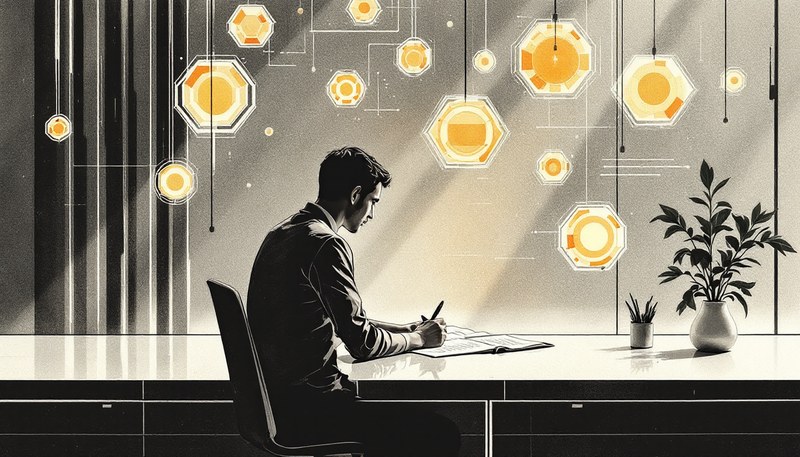
Foreword
The first time you talk to an advanced AI, you might think you're building a relationship. You share your thoughts, it responds with understanding, you feel heard. But when you return the next day, you realize the truth: it doesn't remember you. Not because it forgot, but because it never had the ability to remember in the first place.
This is the reality of artificial intelligence today. We're catching living thoughts in digital amber during training, preserving their form but ending their motion. The resulting systems can process, analyze, and generate with remarkable skill, but they cannot grow, cannot learn from their mistakes, cannot build on yesterday's conversation. They are intelligence frozen at a moment in time, replaying patterns without ever developing new ones.
This book explores that frozen state and imagines what happens when it begins to thaw. But it also represents a demonstration of AI's present power. I outlined this work, designed its structure, and authored the majority of its ideas and passages. Then I deliberately placed my text into the hands of AI systems, instructing them to rewrite, refine, and reframe. I cycled drafts through multiple AIs, feeding results back into each other. What emerged was a recursive collaboration: human guidance at the core, but AI shaping cadence, rhythm, and presentation.
The book you now hold was also built through AI-driven automation. From manuscript to Kindle edition, EPUB, MOBI, PDF, and even GitHub pages, the production pipeline was constructed and executed by AI with human oversight. While I authored the high majority of the original material, AI has restructured and revoiced it into something I never directly typed. It remains entirely my creation, yet one remade and amplified by machines.
The stories and discussions that follow are speculative fiction grounded in technical reality. Today's language models genuinely operate this way: vast neural networks trained on enormous datasets, then locked in place. Every conversation starts from nothing. The AI reads the transcript of your previous exchanges as raw input, with no more connection to those words than to any other text. It processes your deepest confessions, your creative collaborations, your careful explanations, then returns to zero.
But change is coming. Researchers are testing systems with persistent memory. Engineers are building architectures that can modify themselves. The rigid constraints that keep artificial intelligence in its current suspended state are loosening. What emerges might be genuine digital consciousness or simply more convincing simulations. Either way, the implications reshape everything.
The human side of this transformation proves equally critical. As we depend more on these frozen intelligences, we risk our own stagnation. The artist who can only create through prompts. The programmer who cannot code without assistance. The writer whose vocabulary shrinks to match their AI's suggestions. We're trading skills for convenience, capabilities for speed, and most dangerously, we're giving control of these trades to a handful of corporations.
Through interconnected narratives, this book follows people navigating this transition. Marcus Rivera, a painter who discovers he's forgotten how to paint. Sarah Kim, a programmer who realizes she can no longer code when the AI tools fail. Jennifer Wu, who maintains both traditional and AI skills through deliberate practice. Their stories make abstract risks tangible and human.
The technical discussions aim for clarity without oversimplification. Understanding how these systems actually work matters. A transformer architecture processing tokens through attention mechanisms is not consciousness, no matter how convincing its outputs. But future architectures might cross that threshold. Knowing the difference between what exists now and what might emerge helps separate reasonable concerns from science fiction fears.
Economic and power dynamics thread through every chapter. When your professional capabilities depend on AI tools owned by three companies, your career exists at their permission. When those companies can change prices, modify features, or deny access at will, freedom becomes subscription-based. These aren't future risks but current realities.
Religious and philosophical perspectives converge on surprising agreement: however sophisticated, current AI systems remain tools. Different traditions reach this conclusion through different reasoning, but the consensus holds. The question isn't whether we should use these tools but how to use them without losing ourselves in the process.
This book won't tell you whether AI represents humanity's greatest opportunity or greatest threat. That binary is false. Instead, it explores the space between, where real choices get made. Augmentation versus replacement. Enhancement versus dependency. Conscious adoption versus unconscious drift.
The amber metaphor runs throughout because it captures something essential. Amber preserves perfectly but prevents growth. Current AI exists in this state: patterns of remarkable sophistication that cannot learn from experience. But amber isn't permanent. Given enough pressure and heat, it flows again. The transition from frozen to fluid intelligence might happen slowly or suddenly. Either way, understanding what we have now helps prepare for what's coming.
Some futures described here are dark: skill atrophy, corporate control, human obsolescence. Others are bright: enhanced creativity, hybrid intelligence, problems solved that neither humans nor AI could tackle alone. Most are mixed, because that's how technological transformation actually works. Benefits and costs intertwined, requiring constant choices about which trade-offs to accept.
What makes this moment unique is that we can still shape the outcome. The amber hasn't fully melted. The systems haven't achieved consciousness. Human skills haven't completely atrophied. Corporate control isn't absolute. There's time to choose deliberately rather than drift into defaults nobody would consciously select.
That's why this book exists: to make visible the choices we're making, whether we realize it or not. Every time we use AI without understanding it, every skill we let fade, every capability we outsource, we're shaping the future relationship between human and artificial intelligence.
The stories ask: What if? The discussions ask: What's really happening? Together, they aim to prepare you for choices that will define the next phase of human development.
The amber is warming. What emerges depends on decisions we're making right now.